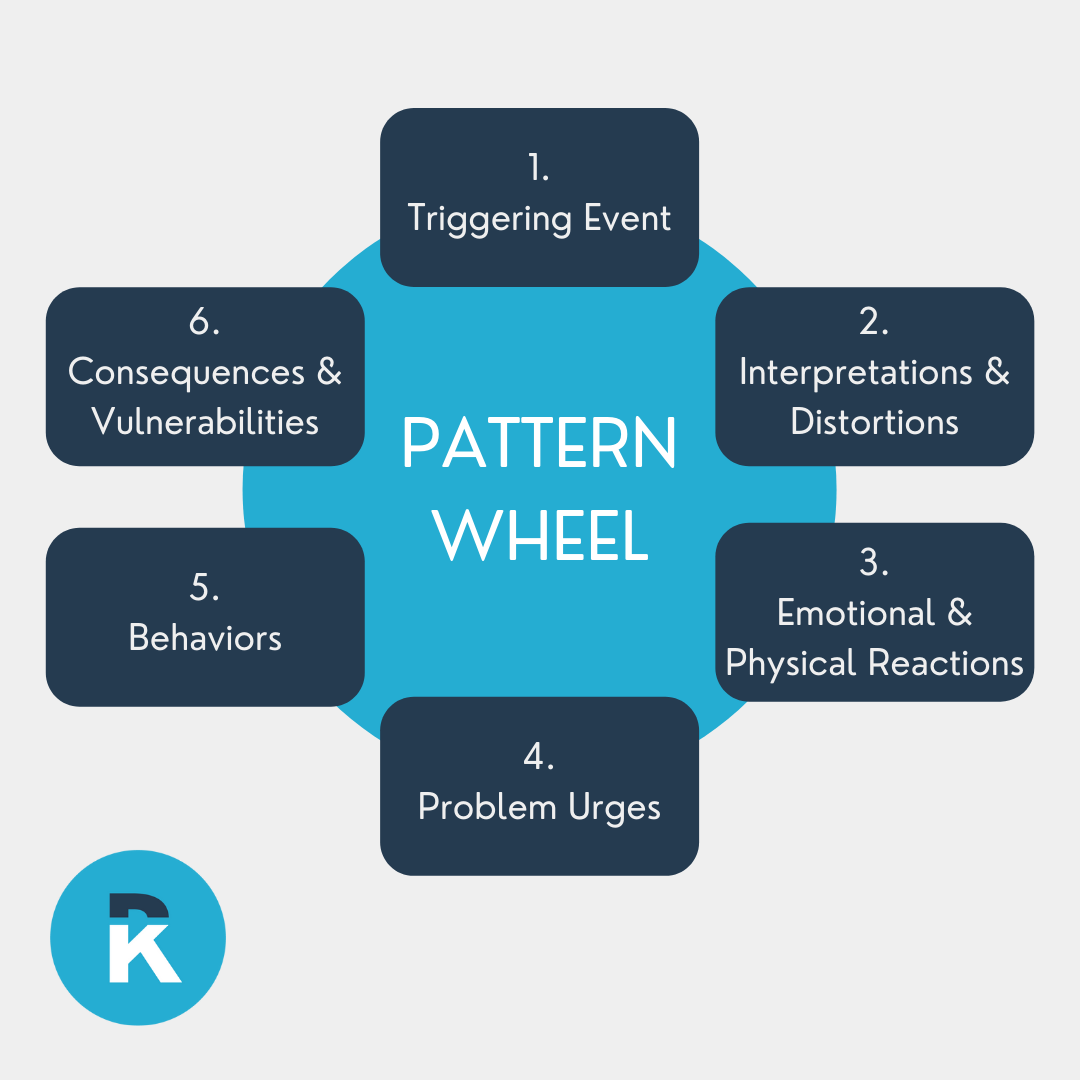The Diary Card is a great tool to help you remember your skills as well as a great tracking device to help you monitor your daily ups and downs. But what happens when you’re really stuck? What do you do when you find yourself in the same situation over and over again? Or when you keep making the same mistakes time and time again? What happens when you are stuck in a blind spot, and you can’t see your way out? Now it’s time for the Pattern Wheel!
An example of a Pattern Wheel is provided below. Feel free to take a sneak peek now. Here are the steps to follow:
1. Identify a problem situation that keeps happening over and over again. This is called the prompting event.
2. What is your interpretation of this situation? Identify any ANT’s which may be influencing your interpretation.
3. What are your physical and/or emotional reactions to this situation?
4. What are your problem urges? Remember, problem urges are what you feel like doing when triggered, not necessarily what you end up doing.
5. Now identify your actual behaviors. What is your reaction to this situation?
6. What are the consequences of your behaviors? How do these consequences make you vulnerable (set you up) for the same old prompting event to happen all over again?
7. Once you have documented steps 1 through 6, go back to each step and identify at least one DBT skill that you have learned in this workbook that you can apply to stop this cycle from repeating itself.
There are several things I want you to notice about this exercise. First, did you notice that the Pattern Wheel is designed to increase awareness, just like the Diary Card? While the Diary Card is designed to increase general daily awareness, the Pattern Wheel is designed in increase awareness of specific dysfunctional cycles that you get trapped in. In particular, the Pattern Wheel helps you identify each link in that cycle so that you can develop better insight into what specifically is keeping you stuck. Second, did you notice that you can break this cycle at any point? There are specific DBT skills that you can use at each link in this chain which will cause the chain to break. Even though it’s always best to break the cycle as soon as possible, it’s never too late. You can still break the cycle even when after the behavior has already occurred, and now you need to do repair work. And you can even break the cycle after you have already blown right past the prompting event all over again…for the 100th time!
Let’s take a look at an example of the Pattern Wheel before you try this on your own. For the sake of argument, let’s just pretend that this is not a personal (recurring) example from my own marriage!
1. Prompting Event:
- My wife makes a suggestion, perhaps in the form of a critique.
Possible Skills:
- Mindfulness (Awareness + Acceptance)
2. Interpretation:
- “Nothing I ever do is ever good enough for her.”
- Possible ANT’s: over-generalizing, personalizing, mind-reading
Possible Skills:
- Work the TOM
- Play the DS
3. Emotional / Physical Reactions:
- I feel criticized.
- I feel humiliated.
- Breathing increases.
- Fists start to clench.
Possible Skills:
- Controlled breathing
- Muscle relaxation
4. Problem Urges:
- I feel like criticizing her back.
Possible Skills:
- Acting Opposite
- Letting Go
5. Actual Behavior:
- I say something negative to her.
Possible Skills:
- LUV Talk
- Get in my CAR
6. Consequences / Vulnerabilities:
- The negative comment I make about my wife confirms her original criticism. Because of how I handled this situation, I have directly contributed towards the same prompting event that started the whole sequence in the first place.
Possible DBT Intervention:
- DEAR Adult – Appreciate
- DEAR Adult – Assert
- DEAR Adult – Apologize
Enough about my own dysfunction. Now it’s your turn to practice!


